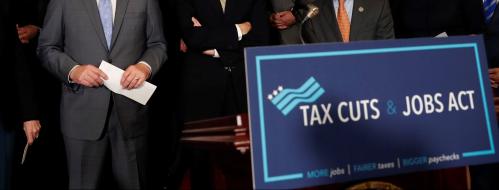This blog was originally published on the AEIdeas blog on October 21, 2019.
The centerpiece of the Tax Cuts and Jobs Act (TCJA) was cutting the corporate rate from 35 to 21 percent. Supporters argued that this would make the United States a more competitive place for business, leading to more economic growth and higher wages. So far, there is little evidence that the law has had such effects.
We want to focus not on the law’s overall effectiveness, but rather on how it could now be amended to produce more inclusive growth and engage the private sector in that task. Businesses can’t be expected to pursue social goals, such as a more broadly shared prosperity, unless they are offered incentives to do so. Tax credits for businesses that train and share profits with their workers are one solution.
Now is a good time to give serious consideration to such measures. In August, the Business Roundtable released a new “Statement on the Purpose of a Corporation.” In it, the organization says that corporations “share a fundamental commitment to all of our stakeholders” and commit to investing in employees and supporting communities.
This is a welcome shift, and policymakers should take note. Corporate tax policy is not just about lowering the corporate rate in hope of spurring growth. Tax policy can also play a role in incentivizing corporations to invest in their workers, promote inclusive growth, and look beyond quarterly revenue projections. The evidence we have on companies that have already done this suggests that it is not only consistent with making a profit, but that it could raise productivity, enhance long-term job growth, and lift wages.
Any number of tax policies could alter the market distribution of income by nudging business enterprises to change their practices. We favor a tax credit for profit sharing. The practice of profit sharing is already quite common. Close to 40 percent of all employees report that they participate in profit-sharing plans with their employers. Southwest Airlines, for example, paid their employees $544 million in profit shares earlier this year, corresponding to an 11 percent bump in compensation.
Does profit sharing lead to employees being paid lower wages or to businesses earning fewer profits? By and large, a wealth of evidence suggests the answer to both questions is no. While cause and effect are hard to sort out, one randomized control trial found that profit sharing raised productivity, increased profits, and reduced employee turnover.
A profit-sharing tax credit could be implemented by reforming Section 162(m) of the internal revenue code. Before TCJA, 162(m) allowed the deductibility of executive pay above $1 million only if it was performance-based. After TCJA, all executive pay above $1 million is nondeductible (although it is now subject to the lower corporate rate of 21 percent). This provision could be further amended to provide a partial credit based on the portion of profits companies share with all employees up to some salary or compensation cap. Effectively, this would levy corporate or business taxes on the share of profits retained by shareholders and owners, encouraging more companies to treat their workers as part of the team that produced the profits in the first place. Such a credit could be paid for by raising the corporate rate back to some more reasonable level, such as 25 percent.
We also favor a worker-training tax credit. While some large companies, such as AT&T, provide robust support for employee training, there is an inherent market failure: Workers are mobile and can leave a company that trains them, so companies have little incentive to invest in their employees. This underinvestment is contributing to a skills gap that is arguably hampering productivity and wage growth.
One concern with a worker-training tax credit is that it may not change behavior but simply give a break to companies that would have trained their employees anyway, thus giving them a “windfall.” For this reason, Aspen Institute scholars have proposed a worker-training tax credit modeled after the Research and Development Tax Credit (a similar plan has been introduced in Congress).
Their proposal would provide a credit for training expenditures above an established base level and be restricted to employees with compensation under $120,000. Windfalls would be limited since the credit would target increases in employer training. The compensation cap would ensure that training opportunities were targeted to lower-wage workers who are the least likely to receive it now.
One important reason to engage businesses in achieving more inclusive growth is the unpopularity of the hefty taxes and transfers needed to achieve the goal without a shift in market incomes. A second reason is that receiving a larger paycheck, rather than a government benefit, contributes to a sense of self-respect and dignity tied to the value of work. To substantially reduce inequality without breaking the bank, we need to raise market incomes for those feeling left behind. To be clear, none of this is an argument for not redistributing in response to unparalleled inequality; it is an argument for not relying solely on redistribution to produce more inclusive growth.
More broadly shared growth may be essential to our democracy’s health. The public is feeling increasingly alienated with how the economy is now working; fewer than half of young adults have a positive view of capitalism. At a time when even American business calls for an update to capitalism, maybe our business tax code could use one too. Let’s amend the TCJA in ways consistent with the Business Roundtable’s new emphasis on stakeholder, as opposed to shareholder, capitalism. Will it work? There are no guarantees. But the alternative might be the end of capitalism and democracy as we have known them.








Commentary
Amend the Tax Cuts and Jobs Act for more inclusive growth and better jobs
October 21, 2019